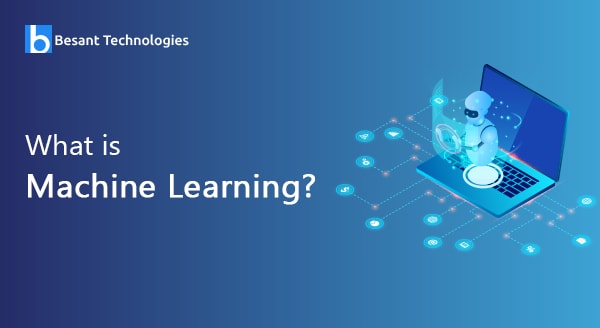
What is Machine Learning?
Introduction to Machine Learning
Hey, what is Machine Learning? This whole blog talks about Machine Learning, what is Machine Learning Model and its respective modules. Machine Learning is one of the top-rated and commanding technologies in today’s IT world. We can also say Machine Learning is a core sub-area of AI (Artificial Intelligence).
There are many people who are not much aware of the importance of Machine learning, how machine learning works and its features. Computational science is very much involved in the Machine Learning model which mainly focuses on interpreting patterns, examining the data structures, decision making and reasoning that are not with human interaction.
The predictable future is expected to have a great impact on the Machine Learning language. Transformation of data and information to knowledge is perfectly possible through a tool called Machine learning is a tool for turning information into knowledge. We can experience a burst of data available in the past 50 years in all categories. If we are not able to analyze and perform research on the data pattern, the whole bunch of data becomes useless.
1. What is Machine Learning
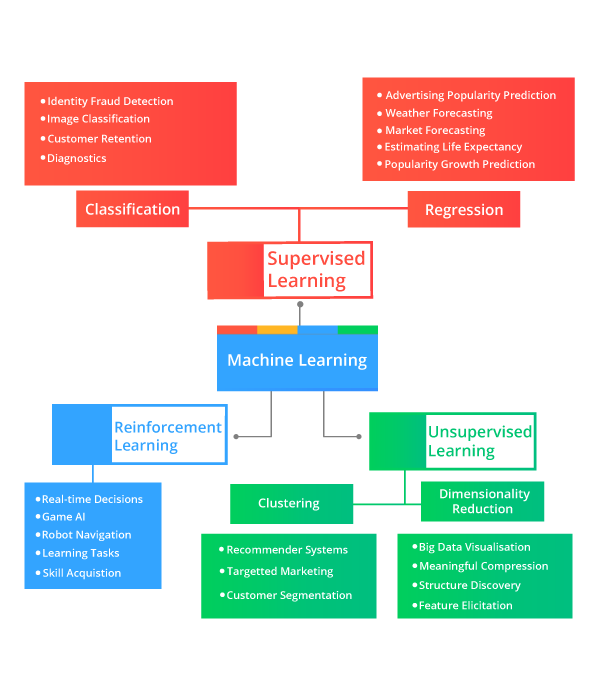 Machine learning is the concept of using the different sample data model to create a mathematical model to understand the specific task. As machine learning deals with business problems the other name for machine learning is predictive analysis. The Supervised machine learning algorithm, unsupervised algorithm, Semi-supervised algorithm, and reinforcement machine learning algorithm are the algorithms of machine learning which are used to make the computers to learn by experience.
Machine learning is the concept of using the different sample data model to create a mathematical model to understand the specific task. As machine learning deals with business problems the other name for machine learning is predictive analysis. The Supervised machine learning algorithm, unsupervised algorithm, Semi-supervised algorithm, and reinforcement machine learning algorithm are the algorithms of machine learning which are used to make the computers to learn by experience.
A list of Machine learning techniques is available mechanically to retrieve the treasured fundamental patterns from complicated data. It is possible to face some obstacles while discovering the challenges in data without the Machine Learning model. For a better and enhanced decision making, we can make use of these discovered patterns and data knowledge to know about a problem and give some predictions on the future. It is obvious that every single day we are interacting with one or other Machine Learning concepts.
Browsing through Google, listen to music, clicking a picture are some of the incidents that we face with Machine Learning. With Machine Learning, there are few advance changes like producing fresh drugs, cancer detection, and self-driving cars. Going forward, we are planning have some discussion on why to use Machine Learning, the difference between Deep Learning and Machine Learning, Different Types of Algorithms, Future of Machine Learning, available job opportunities, and package.

2. Why Use Machine Learning?
With the help of Machine Learning language, you can make your system learn many important factors from different experiences and incidences to see progressions in decision making capability and skillsets. Apart from the advantages like managing a large amount of data, we need to know the answer for a query “Why Machine Learning?”. So, below are the effective points to consider when looking for the benefits of Machine Learning language.
2.1 Expands the Accuracy of Financial Models and Rules:
Machine Learning is playing a significant role in the finance sector. The common benefits of Machine learning in the Finance sector are algorithmic trading, portfolio management, fraud detection, and loan underwriting. It is possible to perform data assessments to analyze and detect gradation and irregularities. These are some of the points which show the accuracy of financial rules and models.
2.2 Healthier Customer Division and Precise Lifetime Value Forecast:
In today’s trend, one of the most challenging parts of the marketers is the customer division and lifetime value estimate. Numerous data from different channels are distributed to the marketing and sales team like lead data, email campaigns, and website visitors. ML is very helpful in predicting discrete marketing offers and enticements.
2.3 Shortens Product Marketing and Aiding in Exact Sales Prediction:
There are multiple benefits to promote a product using Machine Learning. As ML has a huge amount of data, these data can be utilized to alter and review the marketing and sales strategies as per the client’s behavioral design. This will enable the customers to see the right data at the right time without wasting labor time. Even the past behaviors of data and their resolutions can be analyzed with ML.
2.4 Simple Detection of Spam:
Detection of spam was a big issue in earlier days, which got solved very easily in the current days using Machine Learning. To filter the spam, rule-based techniques were used in the earlier days by Email providers. A neural network is the new type of brain technique used for filtering the spam with the help of ML. There are many rules designed across various computer networks and neural networks are good at recognizing the junk mail and phishing messages by evaluating those designed rules.
2.5 Endorsing the Correct Product:
Endorsing a product is not a simple task in this highly competitive market. Machine Learning sounds good in providing product recommendations to enhance the marketing and sales strategy. Based on the purchase history and product identity, data analysis is done with ML. An algorithm is created to identify the hidden patterns within various products and group the similar purchased products into a single cluster. This type of algorithm is known as unsupervised learning.
3. What is Machine Learning Language?
For any Machine Learning projects and assignments, we need to know the topmost languages used for advanced programming. Below listed Machine Learning Languages used in most of the Companies
- Python,
- R
- Lisp
- Prolog
- Java
- C & C++
- Julia
- Shell
- Scala and
- TypeScript
4. Types of Machine Learning
Machine Learning is available all around the world and we all are experiencing any one of the occurrences every day. A new method of data is arising from using Machine Learning. As there are few complexities seen in Machine Learning, it is divided into two main areas called supervised and unsupervised learning. Each type has its own advantages and different working process.
70% of Machine Learning is said to be supervised learning and we can expect only 10 to 20 percent as unsupervised learning. Apart from these two, we have another type called reinforcement learning. Now, let us discuss all three Machine Learning types and know the entire knowledge.
4.1 Supervised Learning
Labeled or known data are used for processing data in supervised learning. As we use known data for a data process, such type of learning is called supervised learning. A Machine Learning Algorithm is designed through which data travel and helping to train the model.
When the model training is over, unknown data can come into the picture for us and receive a fresh response. Some of the best algorithms used in supervised learning are Decision trees, Naïve Bayes, Random forest, Polynomial regression, and Linear regression.
4.2 Unsupervised Learning
Usage of unknown or unlabelled training data is happening in unsupervised learning. This means, the data is very fresh and not visited by anyone before. As the unknown data is used, none of the algorithms can be applied to the inputs and hence we can experience some unsupervised terms originating. The entire data is pushed into a Machine Learning algorithm which is helpful in training the model.
The trained model performs a hunt for a better pattern and provides the necessary response. For unsupervised learning, the algorithms used are Fuzzy means, Apriori, K-means clustering, Partial least squares, Hierarchical clustering, and Singular value decomposition.
4.3 Reinforcement Learning
Like a traditional method of data analysis, we have the algorithm that discovers data via trial and error process, later which results in greater rewards. Actions, agent, and environment are the major components of reinforcement learning. Decision-makers are called agents, everything through which agents interact is called environment, and all the actions performed by the agents are referred to actions here.
When an agent makes a choice of action to increase the expected reward for a specified duration, reinforcement learning happens.
5. Machine Learning Algorithms
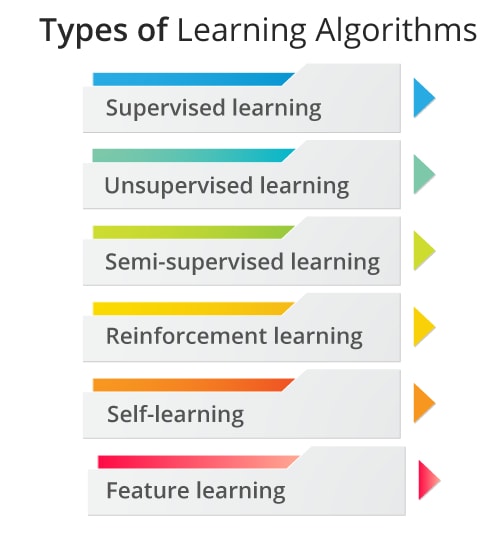
| S. No | Algorithm | Description |
|---|---|---|
| 1. | Linear Regression | · A best line called regression line, is fitted to establish the relationship between dependent and independent variables. |
| · This evaluate the real values depending on the continuous variables. | ||
| · The regression is signified by a linear equation Y=a*X+b, where Y is a dependent variable, a is slope, X is Independent variable and b is Intercept. | ||
| · Two type of Linear Regression are Multiple Linear Regression and Simple Linear Regression | ||
| 2. | Decision Tree | · Decision Tree is a supervised learning algorithm used for classification issues. |
| · Both continuous dependent and categorical variables make use of Decision Tree | ||
| · Using this algorithm, population is divided into two or more set. | ||
| 3. | Logistic Regression | · Logistic Regression is used to evaluate discrete values depending on the available group of independent variables. |
| · Logistic Regression predicts the probability and hence the output is between 0 and 1. | ||
| 4. | Naïve Bayes | · Naïve Bayes is used for large group of data sets and this algorithm is based on Bayes Theorem. |
| · Naive Bayes classifier undertake that a feature presence in a class is dissimilar to any other feature presence. | ||
| · Possible to perform highly cultured classification technique | ||
| 5. | k-Nearest Neighbours | · For the problems on regression and classification, k-Nearest Neighbours algorithm is used. |
| · This is a simple algorithm which stores the entire cases and classification happens for new cases. | ||
| · If working with kNN, variables are expected to be normalized for sure. | ||
| · kNN is computationally posh | ||
| 6. | K-Means | · K-Means comes under unsupervised algorithm that helps in solving the cluster issues. |
| · K-Means very easily classify the provided data set via a firm number of clusters. | ||
| · Clusters are available in K-Means where each cluster contain their own centroid. | ||
| 7. | Random Forest | · A collection of decision tree is said to be a forest and hence we call this algorithm as Random Forest. |
| · This is a trademark term for a collaborative of decision trees. | ||
| · Every individual tree can grow to a larger possible level without cropping. |
6. Machine Learning Models
The models of machine learning are used to reach the level of accuracy and it applies the mathematical concepts towards real-world problems. The input, output, and models are analyzed to give precise predictions. Let us provide some key models of machine learning.
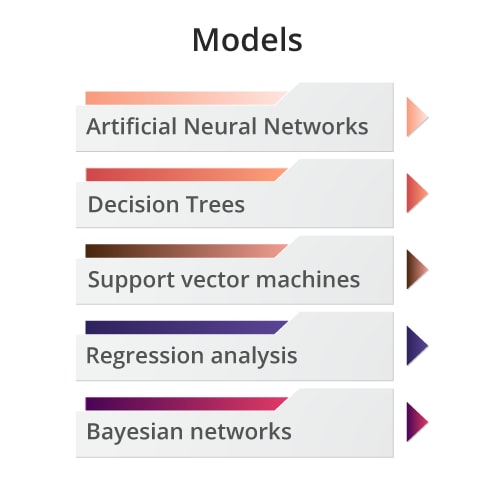
6.1 Artificial Neural Networks
Artificial neurons are signal transmitters that create a connection like the human brain. The connection between two neurons is called as edges and the weight between edges increases or decreases as per the strength of the connection. The model of the ANN approach is developed to duplicate the work of the human brain. The transformation of light into vision and sound into hearing is the work of the brain. Deep learning is the other concept under neural networks which consist of many hidden layers. Speech recognition and computer vision of deep learning are designed like the human brain which became successful.
6.2 Decision trees
Decision trees are predictive modeling to get conclusions to the problem and this is used in subjects like data mining, statistics, and machine learning. Leaves of the tree structure show the class labels and the branches represent the features conjunction that leads or group the labels.
6.3 Support vector machines
SVM is one of the supervised learning methods to identify whether examples used for training falls under one or two categories. SVM performs linear and non-linear classification with high dimensional features of examples.
6.4 Regression analysis
The given data is used along with statistical methods to understand the connectivity among the input variable and the features of the input variable is called a regression analysis. Line or square is drawn to understand the data in mathematical form.
6.5 Bayesian networks
The Bayesian network uses the acyclic graph to represent a set of random variables as a joint probability distribution. The Bayesian network is used to develop a model for the data or extract expert opinion from the given data.
7. Phases of Machine Learning Algorithm
Machine Learning Algorithm is divided into two main phases which are Training Phase and Training Phase.
7.1 Training Phase
Let us discuss the Training phase with an outstanding example. Pick few apples from the market and create a table to list out the physical characteristics of each apple such as size, color, the country to which each apple belongs, shape, vendor name, etc. These characteristics are named as training data. And now list out the outcome of those apples like juiciness, taste, sweetness, ripeness, etc and these are named as output variables. Now all these data altogether must be pushed into the Machine Learning algorithm which is classification and regression. This process learns a correlation model between its excellence and physical characteristics.
7.2 Testing Phase
Let us continue to have an example to explain the Testing Phase. Again, when you are shopping for the apples, you will attempt to get the apple’s characteristics measure that you purchase. This is called test data. The next step is feeding the retrieved test data to the Machine Learning algorithm. Now, the algorithm will use the previous model that you used to compute in the Training phase. Internally, rules may be used by the algorithms. Finally, it is a good chance to purchase good apples with full confidence while shopping as you are aware of the entire apple details.
8. Applications of Machine Learning
Netflix, wall street journal and sun microsystems are some of the companies which make use of machine learning as a recommendation algorithm and diagnostic software. Let us detail some of the applications of machine learning to understand how it supports different processes.
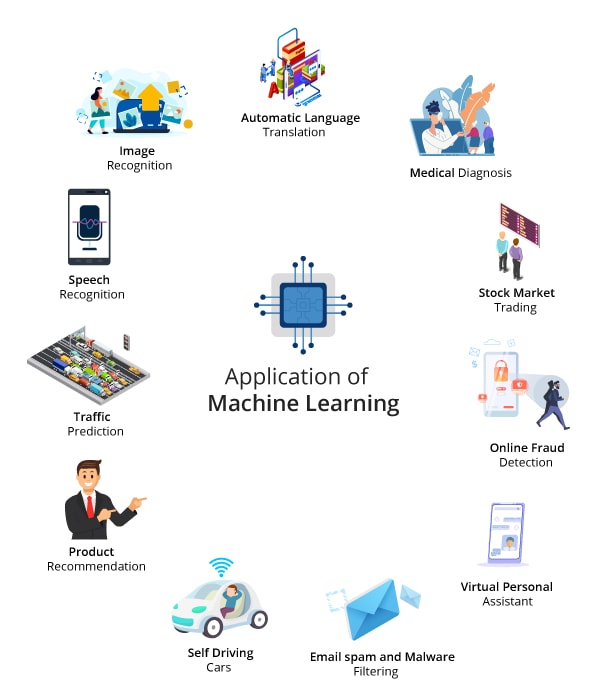
8.1 Health care
Machine learning is applied to the identification of disease which is said to be difficult from human diagnosis. For diseases like cancer and depression, early treatment will safeguard the patient. IBM Watson Genomics is the application of machine learning which is used to make a diagnosis of the tumor. Manufacturing drug, image diagnosis, maintaining health records, data collection and predictions are some of the applications used in the healthcare industry promoted using machine learning techniques.
8.2 Finance
Machine learning is the branch of data science that uses models for analyzing financial data. Agility is the major factor that says that data infrastructure in the finance industry is not ready for analysis. Process automation, Chabot usage, automation in call center work, detecting fraud, improving security, portfolio advisory from robots, and marketing with targeted customers are some of the benefits of machine learning in the finance industry.
8.3 Virtual personal assistants
Machine learning is used for different types of virtual assistants like creating text messages, finding the status of the flight, show directions for particular location, find the location of hotel, request song, handle the phone calls and make phone calls, handle the calendar with organized events, and request for particular song as per commands.
Examples of such virtual assistants incorporated with devices are seen with Google and Alexa. Speech recognition, voice recognition, and image recognition are moving the demand of these virtual assistants.
9. Machine Learning Vs Deep Learning
| S. No | Category | Machine Learning | Deep Learning |
|---|---|---|---|
| 1. | Definition | A technique of analysing data, study more details from that data and later apply the acquired learning to end up in a well-versed decision | A subset of machine learning is called the Deep Learning, which handles the creation and functioning of algorithms. |
| 2. | Hardware dependencies | Machine Learning works on a low-end machine | Deep Learning always needs influential machine which also contains GPU. |
| 3. | Time to execute | Execution happens between few minutes and upto some hours | As Neural network need some time for computing, execution happens for a week or more than that |
| 4. | Data Performance | Machine Learning performance is very good on small sized or medium sized dataset | Deep Learning performance is very good in huge dataset |
| 5. | Ease of interpret | Just few algorithms like decision tree, and logistic are easy to interpret, whereas some are not easy to interpret like XGBoost and SVM | Most often difficult to interpret and we can also say not possible to interpret |
| 6. | Feature Understanding | Machine Learning features are required to understand which signifies the data | Not required to understand the features which signifies the data |
| 7. | Count of algorithms | There are many algorithms available in Machine Learning | Very few algorithms are available in Deep Learning |
| 8. | Time for training | Less time is enough to train the data | More time is required to train the data |
| 9. | Problem Solving approach | Break the issues into different part, solve individually and finally merge to get the result | Problems are solved overall (end-to-end) without breaking into various parts |
| 10. | Algorithms | Decision Tree, Logistic Regression, Linear Regression, and Naïve Bayes are the top algorithms of Machine learning | Convolutional Neural Network, Recurrent Neural Networks, Long Short Term Memory Networks and Stacked Auto Encoders are the top algorithms of Deep Learning |
10. What is Artificial Intelligence?
Now let us see what is Artificial intelligence? AI is a great emerging technology that performs various tasks associated with intelligent human beings. In AI, with a set of programs, a computer is made to think, learn from experience, adjust with fresh inputs or data and work on the tasks. Speech recognition, Machine vision, expert systems, and Natural Language Processing are some of the topmost applications of Artificial Intelligence. Reasoning, Learning, and self-correction are the three cognitive skills mainly focused on AI. Most of the Artificial Intelligence systems are driven by Machine learning. There are many people who think both Machine learning and Artificial Intelligence are the same which is not true. They both are related to one another in some way, but not the same in all aspects. To achieve the AI technology, we make use of Machine learning. To know the detailed difference between Machine Learning and Artificial Intelligence, just refer to the below table.
11. Machine Learning Vs Artificial Intelligence
| S. No | Parameters | Machine Learning | Artificial Intelligence |
|---|---|---|---|
| 1. | Goal | Machine Learning always focus on data accuracy and not bothered about success | AI focus on result and success, but not bothered about accuracy |
| 2. | Solution type | Machine Learning do not concentrate on any solution type and it just provide a solution for the problem | Artificial Intelligence concentrate on finding the optimal solutions |
| 3. | Why to use | Machine Learning permits the system to get the learning from the experience | For a better decision making, AI is primarily used |
| 4. | Scope | Scope of Machine Learning is very much limited | A wide range of scope can be expected on Artificial Intelligence |
| 5. | Features | Self-correction and learning are the features of Machine Learning when a new data is introduced | Self-correction, learning and reasoning the features of Artificial Intelligence |
| 6. | Subsets | For Machine Learning, Deep Learning is the main subset | The two important subsets of Artificial Intelligence are Deep Learning and Machine Learning |
| 7. | Process | Teaching machines to perform a specific task and get the precise outcome | Enabling the system to perform tasks like humans |
| 8. | Applications | Applications of Machine Learning are Google Search Algorithms, Facebook friend tagging suggestions, and Online recommender system | Applications of Artificial Intelligence are Expert system, intelligent humanoid robot, Siri, online playing games and customer support with catboats |
| 9. | Types | Three types of Machine Learning are Supervised Learning, Unsupervised Learning and Reinforcement Learning | Three types of Artificial Intelligence are General AI, Weak AI and Strong AI |
| 10. | Dealing with data | Structured and semi-structured data are handled by Machine Learning | Structured, semi-structured, and unstructured data are handled by Artificial Intelligence |
12. Machine Learning Certification Details
| S. No | Certification Name | Description |
|---|---|---|
| 1. | AWS Certified Machine Learning (Specialty) | AWS Certified Machine Learning (Specialty) certification confirms a learner capability to deploy, implement, design, and uphold Machine Learning (ML) resolutions for the specified business difficulties. Modeling, Data Analysis, Data Engineering, ML implementation and Operations are the four domains addressed in this course. 4 hours of classroom training and 2 hours of digital training is available. |
| 2. | AWS DeepRacer - Driven by Reinforcement Learning | AWS DeepRacer - Driven by Reinforcement Learning is intended to provide practical experience with Reinforcement Learning. You can get the learning on how to build, train and deploy models which would result in completing AWS DeepRacer League. 90 minutes of Digital training is available. |
| 3. | Machine Learning for Business | Machine Learning for Business certification is aiding you to crack the business issues with all possible methods. Use cases, ML terminology, different business issues with examples are discussed in the course. 60 minutes of Digital training is available. |
| 4. | Math for Machine Learning | Through Math for Machine Learning course, you will get the knowledge on linear algebra, univariate & multivariate calculus, probability theorems, matrices and vectors. 8 hours of digital training is available for this course. |
13. Future of Machine Learning
Though there are many predictions on various tools and technologies, we need to know the predictions on the Machine Learning model for sure before opting for this concept for your business. To find the hidden insights and predict any kind of outcomes, Machine Learning technology permits the computer to access and retrieve the information, which leads to notable variations in businesses. Below are some of the forecast on Machine Learning which we can expect in the upcoming years.
- In the upcoming years, many improvements can be seen in unsupervised machine learning algorithms. Better and faster results are expected in improving these algorithms.
- For faster data processing, we need to have integration between machine learning and quantum computers. This is one of the key factors that will happen in the future.
- Increase of Robots: Increased number of robots is expected to appear in the next few years. It is obvious that Robotization is depending on Machine Learning to accomplish multi-agent learning and self-supervised study.
- Boosted personalization: Personalized algorithms will be fine-tuned for availability which would help in getting more benefits and fruitful experience.
- Environments without code: Machine Learning algorithms are taking advanced steps to build up an environment where no one needs to write codes and scripts.
14. Machine Learning Job roles and salary details
| S. NO | Job Role | Description |
|---|---|---|
| 1. | Machine Learning Engineer | Machine Learning Engineers are responsible for creating wonderful algorithms and they are required to focus more on C++, Python, Scala, Java, and JavaScript. Average salary for a Machine Learning Engineer is approximately $110,700. |
| 2. | Data Architect | Data Architects are the ones who work on organization big data network. They will focus more on NoSQL, SQL, Hive, Cassandra, Hadoop, Data Streaming, and MapReduce. Average salary for Data Architect is approximately $188,000. |
| 3. | Data Scientist | In todays trend, Data Scientist is the most wanted role in many industries. They should highly focus on Hive, Python, SAS, R, Spark and Pig. Analytic tools and big data technologies are their weapons to shine in their career. Data Scientists are responsible for cleaning and managing big data. Average salary for a Data Scientist is approximately $91,000. |
| 4. | Data Analyst | To perform work on storing systems, business intelligence concepts, data visualization, data retrieval, Hadoop based analytics and data warehousing, Data Analyst are required in most of the domains and companies. Average salary for a Data Scientist is approximately $83,000. |
15. A Career with Machine Learning
Artificial Intelligence Engineer, Deep learning engineer, quantitative analyst, and systems engineer, Machine learning engineer, data scientist, data engineer, and data analyst are the wide range of opportunities open for the machine learning professionals. The approximate salary of machine learning engineer as per one research is $146,085. Most of the industries rely on the verticals of machine learning. The knowledge of machine learning will skyrocket the career to the next level.
The responsibilities of the machine learning engineer include designing, developing, information processing, test hypothesis, perform data analysis, and develop the business with the help of machine learning models. Specialty certification from AWS provides the in-demand knowledge required to take up different roles with machine learning.
Machine learning is used for a wide range of applications from healthcare, traveling, Finance, and virtual personal assistants. Seamlessly we are standing under the shadow of machine learning which is setting its path in multiple industries. Data are used for multiple purposes with different patterns and one common system to handle data aids for continuous improvement and better predictions.
During uncertain environments, predictions are the best way to reduce the loss. Requirement or feature is the model and training is the process of feeding data to the model for training the machines. The output is the result that can be tested before using machine learning for the business processes. With the help of machine learning, the trends or predictions easily arrived with less human intervention and that is the reason why machine learning is marching towards advancement.
16. Conclusions
Machine Learning has become a bridge for many people to get the best career with a competitive salary. The algorithms of Machine Learning are helping many industries to build high-level designs and patterns to handle a huge number of data. The industries that are more benefited with Machine Learning are Finance, Transportation, Healthcare, Retails and Agriculture. Machine Learning is one of the top-rated and highly demanded technology all over the world. Hence, better to pick this career option and become the most demanding individual.


